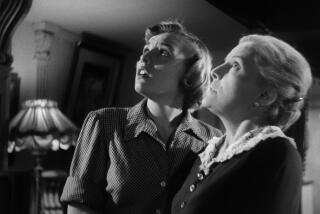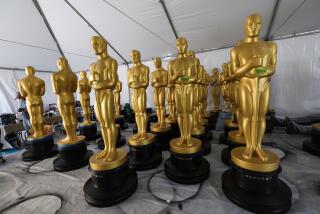Academy Polishes Its Big-Screen Gems
When the Academy of Motion Picture Arts & Sciences began bandying about plans for its 75th anniversary celebration a few years back, one of the suggestions was to hold a screening series of all the best picture winners. But there was a problem inherent in the idea: Were there decent prints of all the films?
“We didn’t want to do it if we couldn’t get a pretty good print of everything,” said Bruce Davis, the academy’s executive director. “There are some films we weren’t sure we could get in good shape.”
The Academy Film Archive has been busy doing restorations as well as some Sherlock Holmes detective work to get the best prints possible for the 75-week series that kicks off tonight at the academy’s Samuel Goldwyn Theater with the second best picture winner, 1929’s “The Broadway Melody.”
“Facets of the Diamond: 75 Years of Best Picture Winners” will continue Monday evenings--save for holidays and Christmas breaks--through December 2003. Besides the Oscar-winning best film, the evenings will also include award-winning short subjects from that year, the best song winner, and trailers for the upcoming week’s movie.
A newly restored version of 1927’s “Wings,” the first best picture winner, will be screened with a full orchestra May 16, 2003. “That would be the same date of the first Academy Awards ceremony,” says Davis.
Obtaining usable prints for the series has made life interesting for Michael Pogorzelski, director of the Academy Film Archive. For example, all of the original 70-millimeter prints of the 1956 winner, “Around the World in 80 Days,” suffer from color fading or are lost.
Most of the prints being screened come from the archive’s own collection. “We are making prints, and we are actually going ahead and doing restoration,” Pogorzelski says. “From the archival prospective, one of the best things to come from the screening series is that we can actually help preserve and restore a title.”
The Academy Film Archive is putting the finishing touches on the restoration of 1933’s “Cavalcade.” “We’re doing the restoration in collaboration with 20th Century Fox,” says Pogorzelski. “The screening in June will sort of be the grand unveiling.”
No negatives or copies of “Cavalcade,” Noel Coward’s family saga, were complete. “They were duped from a couple of different sources,” he says. One negative was copied from a North American release print that had been censored. One excised sequence was a montage of a party that showed drug use and hinted at homosexuality; the new print has restored the complete montage sequence.
The 1938 Oscar winner “You Can’t Take It With You,” says Pogorzelski, is in dire need of work. “It’s a restoration that we would like to do, but there just isn’t enough time to do it before the [July 15] screening,” he says. “The Library of Congress has done work on it. They have done what they can in their collection. But I think it’s time to scour the world to see what’s out there.”
In the case of “The Broadway Melody,” no archive has been able to find a missing Technicolor musical number. The musical sequence is still in the film, but only in black and white. “I don’t know of any original print in two-strip Technicolor,” says Pogorzelski. “There are rumors that pop up every once in a while.”
Actually, Pogorzelski encountered more problems in the prints of the best-picture winners of the ‘70s and ‘80s than in older films. Though the studios have preserved the original negatives, several of the prints from the academy’s archive have faded.
“In terms of our own collection, we are going back and probably having to make new prints of a lot of movies,” he says. “The print stock is especially susceptible to color fading. Our print of ‘Annie Hall’ is completely pink.” Other films that suffered from color fading include 1971’s “The French Connection,” 1976’s “Rocky” and 1980’s “Ordinary People.”
There will be some real gems for film buffs in this series. Pogorzelski boasts that the academy will be showing a “gorgeous print” from the original camera negative of the 1957 winner “The Bridge on the River Kwai.”
“The other great thing about this series is that we have a lot of original dye-transfer Technicolor prints,” says Pogorzelski. “Dye transfer is a printing process where the color doesn’t fade--instead of being created photochemically on a single strip ... the color dyes are literally stamped into the film strip. We have dye-transfer prints of [the first two] “Godfather” films that are absolutely gorgeous.”
In the case of 1951’s “An American in Paris,” 1958’s “Gigi” and 1959’s “Ben-Hur,” the academy will be showing the original dye-transfer prints; these are the same prints academy members saw five decades ago when they were deciding the best-picture winners. “This is a chance to see the films as they were originally seen,” says Pogorzelski.
Davis says the academy is still evolving other festivities. Last Wednesday, there was a kickoff celebration at the academy’s Margaret Herrick Library on La Cienega Boulevard. In September, the Hollywood Bowl is planning a musical tribute to the academy. “We are going to let them pick out the music,” says Davis. In October, the academy will screen a newly restored version of Charlie Chaplin’s 1928 comedy “The Circus,” for which he won a special Academy Award at the first ceremony.
“Facets of the Diamond: 75 Years of Best Picture Winners,” kicks off Monday at the Samuel Goldwyn Theater, Academy of Motion Picture Arts & Sciences, 8949 Wilshire Blvd., Beverly Hills. Screenings are at 8 p.m. Admission is $5, or $3 for students with valid I.D.; a pass to all 75 films is available for $75. For information call (310) 247-3600 or go to www.oscars.org.
More to Read
The biggest entertainment stories
Get our big stories about Hollywood, film, television, music, arts, culture and more right in your inbox as soon as they publish.
You may occasionally receive promotional content from the Los Angeles Times.











